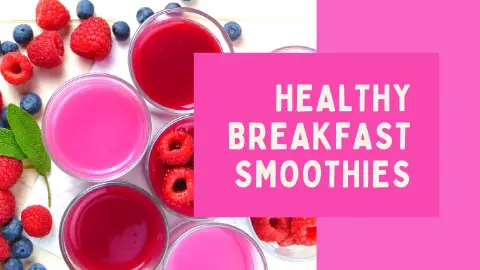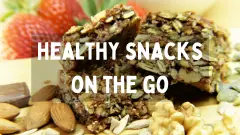Is breakfast important? You’ve probably heard the advice that eating a good breakfast is important for health and weight control. On the other hand, you might have heard that there are weight loss benefits in skipping breakfast altogether. The advice from official health and nutrition organisations is to eat a healthy breakfast. The main reasons for this are to avoid getting too hungry and/or having blood sugar lows, both of which can result in over-compensating with unhealthy foods. While skipping breakfast altogether and lasting until lunch time might result in an overall calorie reduction over the course of the day, it takes a lot of discipline. It’s also not good for everyone. Many people will experience low blood sugar symptoms such as loss of concentration and coordination, irritability, headaches, anxiety, palpitations and shaking. If you don’t have much time or appetite in the morning, then making healthy breakfast smoothies is a good way to make sure you avoid sugar lows and hunger pangs.

What should you have for a healthy breakfast?
The same healthy eating rules apply to breakfast as to any other meal. We should avoid processed foods and foods that are high in fat or added sugar and should have plenty of fruit and veg. Read more about healthy diets here.
Why we need fruit and veg

There are two main reasons we should have a high intake of fruit and veg – dietary fiber and micro nutrients. Fiber is an indigestible protein that makes up the cell walls of plants. It binds to food waste in our bodies and helps it to move through our digestive systems. Micronutrients are the vitamins and minerals that are beneficial to good health and the proper functioning of our body systems. Plants contain a wide variety of these and benefit both short and long term health.
What about protein?

High protein diets continue to be popular, but don’t feature in any official health and nutrition advice. It’s essential to have protein in our diets to make new cells, but the advice is that no more than 15% of our calories should come from protein. If you’re on a training regime for muscle bulk growth you might need additional protein, if not, there’s no point in consuming more protein. Eating protein in itself does not build muscle. However, protein does help us to feel full and can help to slow down carbohydrate digestion, so it’s good to have a moderate amount of protein at each meal.
Examples of protein sources you can use in your breakfast smoothie include:
- Seeds (chia, flax, hemp etc. Chia seeds should be soaked in liquid first as they absorb a lot)
- Protein powders
- Coconut cream or oil
- Yoghurt (including non-dairy)
- Ground nuts
Making healthy breakfast smoothies
You need some sort of blender to make smoothies. You can use an ordinary all-purpose blender, or one specifically made for smoothies. The advantage of smoothie blenders is that you blend the ingredients in a bottle that you can drink them straight out of.
There are an infinite number of possibilities for smoothie recipes, it’s best to just experiment and find out what you like, but as a general guide:
Fruit and vegetables
Aim for 2-3 portions of fruit and veg (1 portion is about 80g/3oz)
Most fruits work well in smoothies, but if you want super smooth smoothies, then avoid fruits with seeds (like raspberries for example) and fruits that are difficult to skin. Alternatively use canned versions. Apricots for example are quite difficult to skin, but canned apricots need no preparation and blend smoothly.
Some people love vegetable smoothies, but they aren’t for everyone, as they can be quite bitter – especially ones made with green vegetables. Good vegetables to use in smoothies include:
- Sweet potato
- Carrots
- Kale
- Celery
- Courgettes/zucchini
- Cucumber
- Spinach
- Broccoli
- Sweet peppers
Should you cook vegetables first?
Some vegetables will blend quite easily, while others such as broccoli and sweet potato will be hard work for your blender and, unless you have a very powerful blender, won’t give a very smooth result. So for the tougher vegetables, it may be better to lightly cook them first. In the case of sweet potato, there’s been a lot of debate about whether they’re safe to eat raw. This is further complicated by the fact that the vegetable known as sweet potato in some regions is actually a yam, which definitely isn’t good to eat raw. Given that cooking first will give you a smoother result anyway, this is probably the best thing to do.
Problems with oxidising
Some fruits, such as banana and avocado go brown very quickly when exposed to oxygen. To avoid this, add a little lemon juice to your smoothie mix. Alternatively, you can add some Vitamin C powder (ascorbic acid).
Liquid
How much liquid you need will depend on what else is in the smoothie and how thick you like your smoothies. Juicy fruit ingredients such as citrus fruits will need less liquid, whereas hard vegetables need a bit more. Start with about half a cup (125ml) and add more if necessary. Liquids you can add include:
- Milk and milk alternatives
- Water
- Juice
Protein
As stated above, we don’t need large amounts of protein in our diets. A dessert spoon of one of the protein foods listed above is a good amount.

